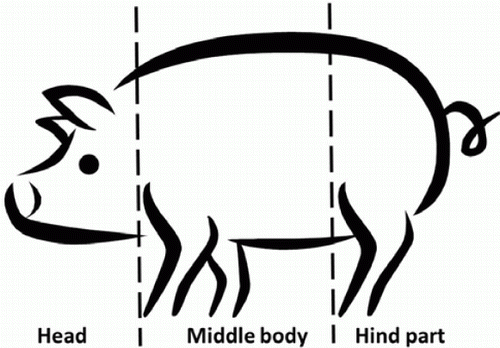Abstract
This study investigated how inclusion of grass/clover silage affected the time budgets and social behaviour of growing/finishing pigs. The behaviour of 128 pigs was observed through video recordings. Pigs fed intact or chopped silage spent a larger proportion of their time active compared with pigs fed silage in pelleted form or fed only cereal-based feed. There was a trend for pigs fed silage in pelleted form or fed only cereal-based feed to respond strongly to social interactions more often than pigs fed intact or chopped silage, irrespective of initial performing pig behaviour. Pigs in groups fed intact silage had a lower number of wounds from violent social interactions on their bodies. Thus, additional provision of silage in an environment enriched with straw can further improve pig welfare.
Introduction
In pig production, provision of straw as a substrate for performance of species-specific behaviours such as foraging and exploration is considered to be one of the most efficient ways to reduce the occurrence of injurious and potentially harmful behaviours, e.g. ear and tail biting (EFSA, Citation2007). However, additional access to roughage can increase the time pigs spend eating and provide them with better opportunities to perform foraging and exploration (Olsen et al., Citation2000).
Due to the ability of legumes to fix nitrogen from the atmosphere, a mixed ley crop is often included in the crop rotation. When ley forage is available on the farm, it can be used as a locally produced feed resource for pigs (Webrink, Citation1994; Sehested et al., Citation2004; Heyer et al., Citation2006; Høøk Presto et al., Citation2011). Besides adding to the nutrient supply of the pigs, grass/clover silage contributes to sustainable use of arable land without mineral fertilizers and may also improve pig welfare (Presto et al., Citation2009).
In enriched housing or outdoor housing systems, pigs spend a large proportion of their time rooting and foraging in different substrates (Beattie et al., Citation2000; Scott et al., Citation2006; Morrison et al., Citation2007). Pigs housed in conventional pens have limited possibilities for rooting and foraging and it has been suggested that pigs sometimes redirect their foraging and exploration behaviour towards pen fittings and other pigs (e.g. Vanputte, Citation1969; EFSA, Citation2007). In fact, pigs in barren environments are more involved in nosing, biting and aggressive encounters with other pigs than pigs housed in enriched environments (Lyons et al., Citation1995; Beattie et al., Citation2000).
Additional access to roughage increases the time pigs spend eating and increases their opportunities to perform foraging and exploration. However, the form in which the roughage is fed may influence pig behaviour. Therefore, the aim of the present study was to investigate how grass/clover silage (1) fed as intact silage separately from commercial cereal-based feed, (2) chopped and mixed with the commercial feed, or (3) mixed together with the commercial feed and pelleted, affect pig time budgets and social behaviour.
Materials and methods
The experiment was performed at the Research Station of the Swedish University of Agricultural Sciences at Funbo Lövsta outside Uppsala (latitude 60° north) from autumn to spring (September 2010 to May 2011). The experiment was performed according to Swedish regulations concerning animal use in experiments (Ministry for Rural Affairs, Citation1988).
Animals and housing
In total, 128 growing/finishing pigs (Swedish Yorkshire×Hampshire) from two production batches (batch one from September 2010 to January 2011; batch two from January 2011 to May 2011) were included in the experiment from approximately 30 kg live weight [30.7±4.55 kg and 70.7±2.89 days of age (Mean±SD)] until slaughter, which occurred at an approximate live weight of 110 kg [108.4±8.31 kg and 167.2±7.62 days of age (Mean±SD)]. At 30 kg live weight, pigs from 10 litters (birth litters, cross-fostering was not applied) of each of the two production batches were allocated to eight pens with eight pigs per pen, i.e. in total 32 pigs per treatment at the start of the experiment. The distribution of pigs was balanced with regard to litter and sex, e.g. no siblings in the same pen and four gilts and four castrates per pen. The pens had a concrete floor in the feeding and lying area, and a slatted dunging area at the back of the pen (1/3 of pen area). The total area was 14.8 m2, giving a floor area of 1.9 m2 per pig. The partitions between the pens were made of metal bars in the dunging area and solid walls in the eating and lying area. A 4.5 m long feed trough was provided along the front of the pen and four water nipples were placed in the slatted area. All pens were provided with approximately 1 kg straw per day.
Pigs were fed either commercial cereal-based feed + chopped silage mixed and fed together (SM); commercial feed + intact silage fed separately (SS); commercial feed + milled silage, mixed and pelleted (SP); or commercial feed alone (C), with four pens (pig groups) per treatment. The pigs were fed twice daily (7 am and 3 pm) according to Swedish energy recommendations (Simonsson, Citation2006). The silage used in the SM, SS and SP treatments contained 9.04 MJ metabolizable energy (ME) and 129 g crude protein (CP) per kg dry matter (DM) and constituted 20% of the diet on an ME basis. Representative samples of feed were collected and analyses for DM, CP, ash, crude fat, neutral detergent fibre (NDF) and gross energy and are presented in .
Table I. Chemical composition of feeds and feedstuffs.
Of the 128 pigs entering the experiment, five were culled before slaughter. One pig in the SM treatment in batch one, one pig in the SP treatment in batch two and one pig in the C treatment in batch two were culled in the first week of the experiment due to injuries caused by fighting at mixing. Moreover, two pigs in the SM treatment (one in batch one and one in batch two) were culled in weeks six and eight of the experiment due to lameness.
Behaviour recording
The behaviour of the pigs was observed in video recordings from four occasions (48 hours per observation occasion) at approximately 30, 50, 70 and 100 kg live weight [corresponding to 79.5±3.66, 110.9±8.90, 128.7±3.41 and 149.7±3.41 days of age at the start of each respective observation occasion (Mean±SD)]. To estimate the time budget of the pigs, the number of pigs in the pen fulfilling the definitions of the variables for activity, body posture and location in the pen described in were recorded with instantaneous scan sampling every 30 minutes. The video cameras were sensitive to infra-red light, thus scan samplings were performed day and night for 48 hours per observation occasion. Social interactions were recorded continuously from 15 to 5 minutes before and from 5 to 15 minutes after each feeding event (twice per day, am and pm). For each social interaction, the location in the pen and the behaviour of the performing and receiving pig were recorded according to the definitions presented in . After a pause in an interaction for at least 30 seconds, a new approach from the performing pig was considered a new social interaction.
Table II. Ethogram of behaviours of pigs in the video recordings.
Recording of wounds and cleanliness
The number of wounds and the cleanliness of the pigs and the pen floor were recorded once, approximately one week before the first slaughter event. For each individual pig, the numbers of fresh and old wounds (partly healed or visual scars) were counted on the head, middle and hind part of the body as indicated in . In addition, the dirtiness of each body part was scored according to a three-point scale, where one means that the whole body part was clean, two that half the body part was contaminated with faeces and three that the whole body part was contaminated with faeces. The cleanliness of the laying area of the pen was scored as the number of clean and dry quarters of the pen floor (1–4). All wound and cleanliness scorings were performed by the same person. Before data analyses, average number of wounds and cleanliness score per pig was estimated for each pen.
Statistical analyses
Statistical analyses were performed using SAS software, version 9.2 (SAS, Citation1990). Descriptive statistics were calculated using procedure FREQ.
Differences between treatments in the time budgets of the pigs were analysed with ANOVA using procedure MIXED. Average percentage of time spent lying, eating, nosing or biting other pigs, nosing or biting pen fittings or floor and in the different functional areas of the pen (in front of feed trough, lying area and slatted dunging area) were estimated per pen and observation occasion. Pen averages were analysed with a model including the fixed effects of treatment (SM, SS, SP and C), batch (one and two), observation occasion (four occasions at approximately 30, 50, 70 and 100 kg of live weight), pen nested within treatment and batch (16 pens), the interaction between treatment and batch and the interaction between treatment and observation occasion. Observation occasion was included with REPEATED statement to model an unstructured covariance structure (choice based on smallest AIC-statistics) within pen. Pair-wise comparisons were adjusted for multiple comparisons according to the Tukey method.
For each pen and feeding event (am and pm at each observation occasion), the average number of social interactions per pig before and after feeding was estimated (expressed as average number per pig per 10 minutes of observation with pen as experimental unit). Differences between treatments were analysed with ANOVA using procedure MIXED. The model included the fixed effects of treatment, batch, observation occasion, time of feeding (am and pm), pen nested within treatment and batch, the interaction between treatment and batch, the interaction between treatment and observation occasion and the interaction between treatment and time of feeding. Observation occasion was included with REPEATED statement to model a compound symmetry covariance structure (choice based on smallest AIC-statistics) within pen. Pair-wise comparisons were adjusted for multiple comparisons according to the Tukey method.
Differences between treatments in average number of wounds and dirtiness scores per pig per pen (recorded once right before slaughter, pen as experimental unit) were estimated with ANOVA using procedure GLM and a model including the fixed effects of treatment and batch. The number of pigs in the pen at the time of scoring was included as a continuous covariate.
In all models where pen was included, the effect of pen included both the effect of the social environment in the unique pig group kept in the pen and the effect of the environment in the physical pen.
Residuals of all dependent production parameters in the ANOVA analyses were examined for normal distribution using PROC UNIVARIATE, considering the Shapiro–Wilks test for normality and a normal probability plot, and all were found to be normally distributed.
Results
Time budgets
The pigs spent on average 76.5% of their time lying down and during 91.4% of that time they were inactive. Pigs fed pelleted feed (SP and C treatments) spent the largest proportion of their time in lying position and pigs fed chopped or intact silage (SM and SS treatments) the smallest proportion [72.6a, 74.8a, 79.3b and 79.2b% of time in lying position in treatments SM, SS, SP and C, respectively (least square means), standard error = 0.92, p=0.002, F=13.4, N=64]. Differences in pig time budgets between treatments are presented in . Pigs in the SS treatment spent a larger proportion of their time eating (p<0.003, F=10.9, N=64) and pigs in the SM treatment spent a larger proportion of their time nosing or biting the pen floor than pigs in the other treatments (p<0.004, F=10.3, N=64).
Figure 2. Proportion (%) of time (least square means±standard error) that pigs in treatments SM, SS, SP and C spent eating, nosing/biting the pen floor, nosing/biting pen fittings and nosing/biting other pigs. Different letters (a, b) for different treatments indicate pair-wise differences at p<0.1. N=64.

Differences in pigs' location in the pen between treatments are presented in . Pigs in the SM and C treatments spent more time in front of the feed trough than pigs in the SS treatment (p<0.032, F=4.9, N=64). Instead, the pigs in the SS treatment spent more time in the lying area (p<0.011, F=7.33, N=64) with a larger proportion of time eating there, as indicated in . In front of the feed trough, SM pigs spent a larger proportion of time nosing or biting the pen floor compared with pigs in the other treatments. Compared with SP pigs, SM pigs tended to spend a smaller proportion of their time in the slatted area of the pen (p<0.052, F=4.0, N=64) as shown in .
Figure 3. Proportion (%) of time (least square means±standard error) that pigs in treatments SM, SS, SP and C spent located in front of the feed trough, in the lying area and in the slatted area. Different letters (a, b) for different treatments indicate pair-wise differences at p<0.1. N=64.
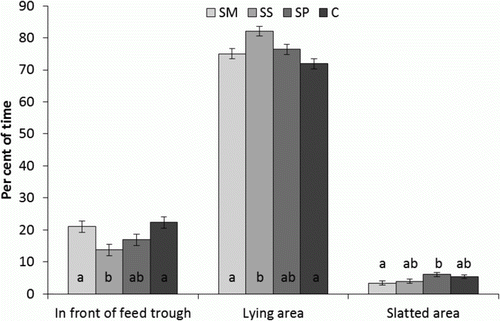
Table III. Proportion (%) of time spent eating, nosing/biting pen floor, nosing/biting pen fittings, nosing/biting other pigs, in front of the feed trough, in the lying area and in the slatted area, per treatment.
Observation occasion (at 30, 50, 70 and 100 kg of live weight) significantly (p<0.05) affected the time budgets of the pigs, indicating that the proportion of time spent eating and nosing other pigs decreased with age. Moreover, pigs spent more time lying down and nosing pen fittings at 50 kg compared with the other three observation occasions. The proportion of time spent in the slatted area and in front of the feed trough increased with age, while time spent in the lying area of the pen decreased. Production batch had a significant effect on time spent eating, lying down, nosing pen fittings, nosing other pigs and pig location in the pen. There was a significant interaction between treatment and observation occasion for proportion of time pigs spent lying and between treatment and batch for proportion of time pigs spent eating, lying, nosing pen fittings and time spent in front of the feed trough and in the lying area.
Social interactions
Irrespective of treatment, pigs performed a higher number of social interactions in the period 15 to 5 minutes before feeding than in the period 5 to 15 minutes after feeding as indicated in a and b. The most frequent social interaction performed before feeding was nosing other pigs and the most frequent social interaction performed after feeding was lifting other pigs. More detailed analyses of the different behaviours performed before feeding (presented in a) showed that pigs in the SP treatment tended to lift other pigs more frequently than pigs in the other treatments (p<0.052, F=4.01, N=128). Pair-wise differences also indicate that pigs in the SP treatment nosed other pigs more frequent than pigs in the SS and C treatment and bit or head knocked other pigs more frequent than pigs in the SM treatment, even though the overall effect of treatment was not significant. After feeding however (presented in b), lifting of other pigs was instead performed more frequently by SM pigs (p<0.083, F=3.2, N=123), and pigs in the SS treatment showed a lower frequency of nosing other pigs (p<0.068, F=3.5, N=123) than those in the other treatments. After feeding, pigs in the SM and SP treatments displayed a higher frequency of climbing other pigs (p<0.012, F=7.2, N=123) compared with pigs in the other two treatments.
Figure 4. Number of nose, lift, bite/head knock and climb interactions (least square means±standard error) per pig in the period: (a) 15–5 minutes before and (b) 5–15 minutes after feeding in treatments SM, SS, SP and C. Different letters (a, b) for different treatments indicate pair-wise differences at p<0.1. N=123–128.
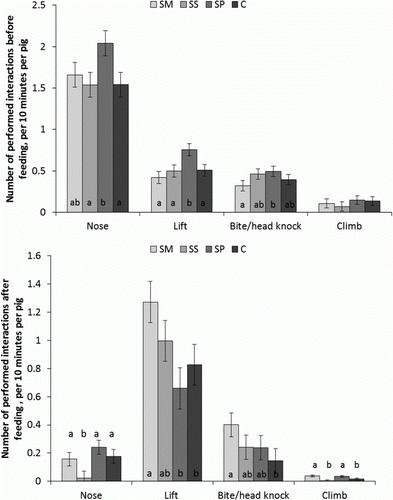
Batch affected the frequency of performed bites/head knocks before feeding (p<0.1) and the frequency of lifting other pigs before feeding (p<0.05). Observation occasion affected the frequency of nosing other pigs before and after feeding, bite/head knock and lifting other pigs after feeding and climbing other pigs before feeding (p<0.05 for all). There were significant interactions between treatment and batch for frequency of climbing other pigs after feeding (p<0.05) and between treatment and observation occasion bite/head knock (p<0.05) and climbing other pigs (p<0.1) after feeding.
As presented in , receiving pigs reacted less commonly when nosed by a performing pig than when climbed on, lifted, bitten or head-knocked by a performing pig. Although there were no major differences between treatments in the reactions of the receiving pigs, there was a trend for pigs in the SP and C treatments to exhibit stronger reactions (return approach to social interactions) more frequently than SM and SS pigs, irrespective of the behaviour of the performing pig.
Figure 5. Reaction of receiving pigs: proportion (%) of social interactions per treatment (SM, SS, SP and C) with each specific reaction (return approach, avoid, no reaction and receiving pig in other pen) when the performing pig nosed, lifted, bit/head-knocked or climbed on the receiving pig. N=123–128.
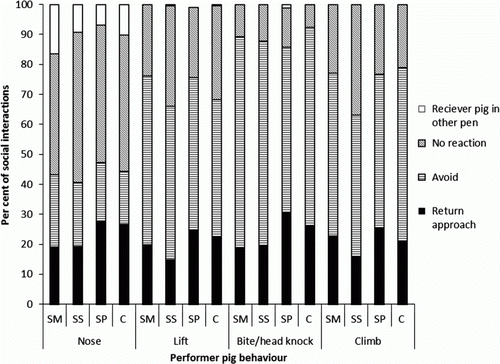
Wounds and dirtiness
Pigs in the SS treatment tended to have a lower total number of wounds on their bodies at the end of the growing/finishing period than pigs in the SM and C treatments [10.5a, 5.72b, 8.74ab and 13.2a wounds per pig in treatments SM, SS, SP and C, respectively (least square means), standard error = 1.74, p<0.068, F=3.25, N=16]. More detailed investigations presented in showed that the pigs in the SS treatment had the lowest average number of wounds on the head (p<0.2177, F=1.76, N=16), middle (p<0.036, F=4.22, N=16) and hind part of the body (p<0.105, F=2.67, N=16) and that the pigs in the C treatment had the highest number of wounds on the middle and hind part of the body. The pigs had on average a cleanliness score of 1.2±0.20 (mean±standard deviation) per body part and the pens had on average 2.5±0.63 clean and dry quarters of the concrete floor. There were no significant differences between treatments in the cleanliness of either the pigs or the pen floors.
Figure 6. Number of wounds per pig (fresh and old) on the head, middle and hind part of the body in the SM, SS, SP and C treatments (least square means±standard error). Different letters (a, b) for different treatments indicate pair-wise differences at p<0.1. N=16.
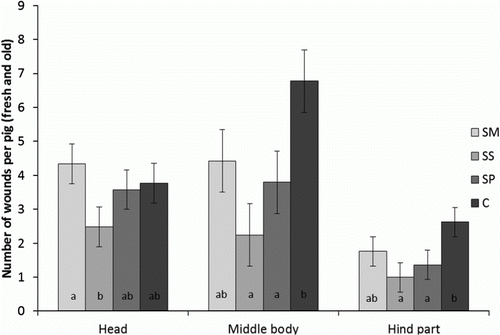
There were significant effects (p<0.05) of batch and number of pigs in the pen on total number of wounds and numbers of wounds on the head, middle and hind part of the body. There was a higher number of wounds in batch two compared with batch one and an increase in number of wounds with an increasing number of pigs in the pen.
Discussion
Under feral conditions, pigs spend most of their day foraging and exploring the environment in their search for feed (Studnitz et al., Citation2007). However, in commercial pig production the pigs are usually fed a restricted amount of a concentrated diet twice or three times per day. In this experiment the pigs fed silage, either chopped and mixed with commercial feed, or intact and fed separately from the commercial feed were more active and spent a larger proportion of their time foraging than the pigs fed the pelleted feed. This was despite the fact that the SP diet had the same ingredients as the SM and SS diets. However, in the SP treatment the roughage was dried, milled and pelleted together with the commercial feed. Pigs kept in environments enriched with straw are reported to be more active than pigs in barren environments (Beattie et al., Citation2000). The results from the present study show that further enrichment with grass/clover silage stimulates pigs to be even more active (i.e. spend less time lying down).
Pigs lacking opportunities to forage or explore their surroundings may redirect these behaviours towards other objects, usually their pen mates and the pen equipment (Lyons et al., Citation1995; Beattie et al., Citation2000). In the present experiment, the pigs fed only pellets spent on average a larger proportion of their time nosing and chewing pen fittings and nosing and biting other pigs than the pigs fed wet silage which could indicate that increased possibilities to perform foraging behaviour can lower the frequency of manipulation of other pigs. Even though this trend was clear, the difference was not statistically significant.
Pigs fed chopped silage mixed with commercial feed spent approximately twice as much time nosing and biting the floor in front of the feed trough compared to pigs in the other treatments (). This might be because these pigs moved a lot of their feed out onto the floor where they manipulated the feed mix, probably sorting out and consuming the most desirable parts. The pigs fed intact silage separately spent more time in the lying area than those in the other treatments. In these pens, the feed-rack was placed on the side wall between the pens, thus the pigs were probably sorting and consuming the silage that fell down from the feed-rack.
One reason for more lifting and bite/head knocking towards other pigs among the pigs in the SM treatment might be that they manipulated and separated out desirable parts of the feed on the pen floor. This in turn probably resulted in more interactions between the pigs. While the type of social interactions (nose, bite, etc.) was recorded, it was not possible to assess the severity of the behaviours by only observing the performing pigs. The severity of social interaction can be assessed by the response of the receiving pig, as suggested by Brunberg et al. (Citation2011). As expected, the reactions were stronger (avoidance or return approach) when the performing pig climbed on, lifted, bit or head-knocked the receiving pig than when it only nosed (). Moreover, the reaction to the social interactions seemed to be stronger (i.e. a higher proportion of interactions were met with a return approach from the receiving pig) among pigs fed only pellet feed, irrespective of the type of the interaction performed.
Another way to estimate the amount and severity of aggressive interactions is to count the number and severity of wounds on different parts of the pig body (Broom, Citation1991). In the present experiment, pigs fed intact silage had the lowest number of wounds on the head, middle part and hind quarters of the body. This indicates a relatively low level of violent social interactions in those pig groups. Pigs fed only commercial cereal-based feed had the highest number of wounds on the middle and hind part of the body. This is in agreement with previous studies showing that housing in barren environments causes more body damage from aggression than housing with straw bedding and more space allowance (Lyons et al., Citation1995; Guy et al., Citation2002). Our results provide additional evidence that in an environment already enriched with straw, provision of intact silage has the potential to further reduce damaging social behaviour. Comparisons between the pigs in the two pelleted feed treatments showed a higher number of wounds among pigs fed cereal-based feed, indicating that even when roughage is milled and pelleted, it influences the social environment in a pig group. This finding is probably not explained by better opportunities for foraging among pigs fed pellet silage, but can possibly be explained by a higher fibre content in the pelleted silage, leading to a longer period of satiety. The group size and animal density for pigs in this study was lower than what is common in most commercial production systems. It is possible that the positive effect of intact and pelleted silage on injurious behaviour would be even larger in such systems.
In conclusion, pigs fed chopped or intact silage in addition to straw in the present study were more active and spent a larger proportion of their time foraging than pigs fed only pelleted feed and straw. Moreover, provision of silage was found to influence the social behaviour of pigs. Pigs in groups fed chopped or intact silage expressed a lower proportion of severe reactions to social interactions and pigs fed intact silage had lower number of wounds on their bodies. Taken together, the results indicate that in housing environments already enriched with straw, provision of silage has the potential to further improve pig welfare.
Acknowledgements
This study was funded by the Swedish Farmers' Foundation for Agricultural Research. The authors thank the staff at the Lövsta pig research unit at the Swedish University of Agricultural Sciences.
References
- Beattie , V. E. , O'Connell , N. E. and Moss , B. W. 2000 . Influence of environmental enrichment on the behaviour, performance and meat quality of domestic pigs . Livestock Production Science , 65 : 71 – 79 . doi: 10.1016/S0301-6226(99)00179-7
- Broom , D. M. 1991 . Animal welfare: Concepts and measurement . Journal of Animal Science , 69 : 4167 – 4175 .
- Brunberg , E. , Wallenbeck , A. and Keeling , L. J. 2011 . Tail biting in fattening pigs: Associations between frequency of tail biting and other abnormal behaviours . Applied Animal Behaviour Science , 133 : 18 – 25 . doi: 10.1016/j.applanim.2011.04.019
- EFSA . 2007 . The risks associated with tail biting in pigs and possible means to reduce the need for tail docking considering the different housing and husbandry systems – Scientific Opinion of the Panel on Animal Health and Welfare . EFSA Journal 611 , 1 – 13 .
- Guy , J. H. , Rowlinson , P. , Chadwick , J. P. and Ellis , M. 2002 . Health conditions of two genotypes of growing–finishing pig in three different housing systems: Implications for welfare . Livestock Production Science , 75 : 233 – 243 . doi: 10.1016/S0301-6226(01)00327-X
- Heyer , A. , Andersson , H. K. and Lundstrom , K. 2006 . Performance, carcass and technological meat quality of pigs in indoor and outdoor production systems . Acta Agriculturae Scandinavica Section A – Animal Science , 56 : 55 – 64 . doi: 10.1080/09064700600670904
- Høøk Presto , M. , Rundgren , M. & Wallenbeck , A. 2011 . Grass/red clover silage to growing/finishing pigs – Influence on performance and carcass quality . In 62nd Annual Meeting of the European Association for Animal Production , Stavanger , Norway , p. 203 .
- Lindberg , J. E. and Andersson , C. 1998 . The nutritive value of barley-based diets with forage meal inclusion for growing pigs based on total tract digestibility and nitrogen utilization . Livestock Production Science , 56 : 43 – 52 . doi: 10.1016/S0301-6226(98)00146-8
- Lyons , C. A. P. , Bruce , J. M. , Fowler , V. R. and English , P. R. 1995 . A comparison of productivity and welfare of growing pigs in four intensive systems . Livestock Production Science , 43 : 265 – 274 . doi: 10.1016/0301-6226(95)00050-U
- Ministry for Rural Affairs . 1988 . Djurskyddslag (1988:534) . Goverment Offices of Sweden, Regeringskansliets rättsdatabaser .
- Morrison , R. S. , Johnston , L. J. and Hilbrands , A. M. 2007 . The behaviour, welfare, growth performance and meat quality of pigs housed in a deep-litter, large group housing system compared to a conventional confinement system . Applied Animal Behaviour Science , 103 : 12 – 24 . doi: 10.1016/j.applanim.2006.04.002
- Olsen , A. W. , Vestergaard , E. M. and Dybkjaer , L. 2000 . Roughage as additional rooting substrates for pigs . Animal Science , 70 : 451 – 456 .
- Presto , M. , Algers , B. , Persson , E. and Andersson , H. K. 2009 . Different roughages to organic growing/finishing pigs – Influence on activity behaviour and social interactions . Livestock Science , 123 : 55 – 62 . doi: 10.1016/j.livsci.2008.10.007
- SAS Institute Inc . 1990 . SAS/STATs User's Guide . ( Gary , NC : SAS Institute ).
- Scott , K. , Chennells , D. J. , Campbell , F. M. , Hunt , B. , Armstrong , D. , Taylor , L. , Gill , B. P. and Edwards , S. A. 2006 . The welfare of finishing pigs in two contrasting housing systems: Fully-slatted versus straw-based accommodation . Livestock Science , 103 : 104 – 115 . doi: 10.1016/j.livsci.2006.01.008
- Sehested , J. , Soegaard , K. , Danielsen , V. , Roepstorff , A. and Monrad , J. 2004 . Grazing with heifers and sows alone or mixed: Herbage quality, sward structure and animal weight gain . Livestock Production Science , 88 : 223 – 238 . doi: 10.1016/j.livprodsci.2003.11.008
- Simonsson , A. 2006 . Fodermedel och näringsrekommendationer för gris [Feed and nutrition recommendations for pigs] . Department of Animal Nutrition and Management, Swedish University of Agricultural Sciences Rapport 266. (in Swedish) .
- Studnitz , M. , Jensen , M. B. and Pedersen , L. J. 2007 . Why do pigs root and in what will they root? A review on the exploratory behaviour of pigs in relation to environmental enrichment . Applied Animal Behaviour Science , 107 : 183 – 197 . doi: 10.1016/j.applanim.2006.11.013
- Vanputte , G. 1969 . An investigation into tail-biting among fattening pigs . British Veterinary Journal , 125 : 511 – 517 .
- Webrink , L. 1994 . Vallfoder till svin – kemisk sammansättning, näringsvärde och användbarhet – en litteraturöversikt. Examensarbete [Ley crop to pigs – chemical composition, nutritional value and utility – a literature review] . Department of animal nutrition and health. Swedish University of Agricultural sciences 57. (in Swedish) .
